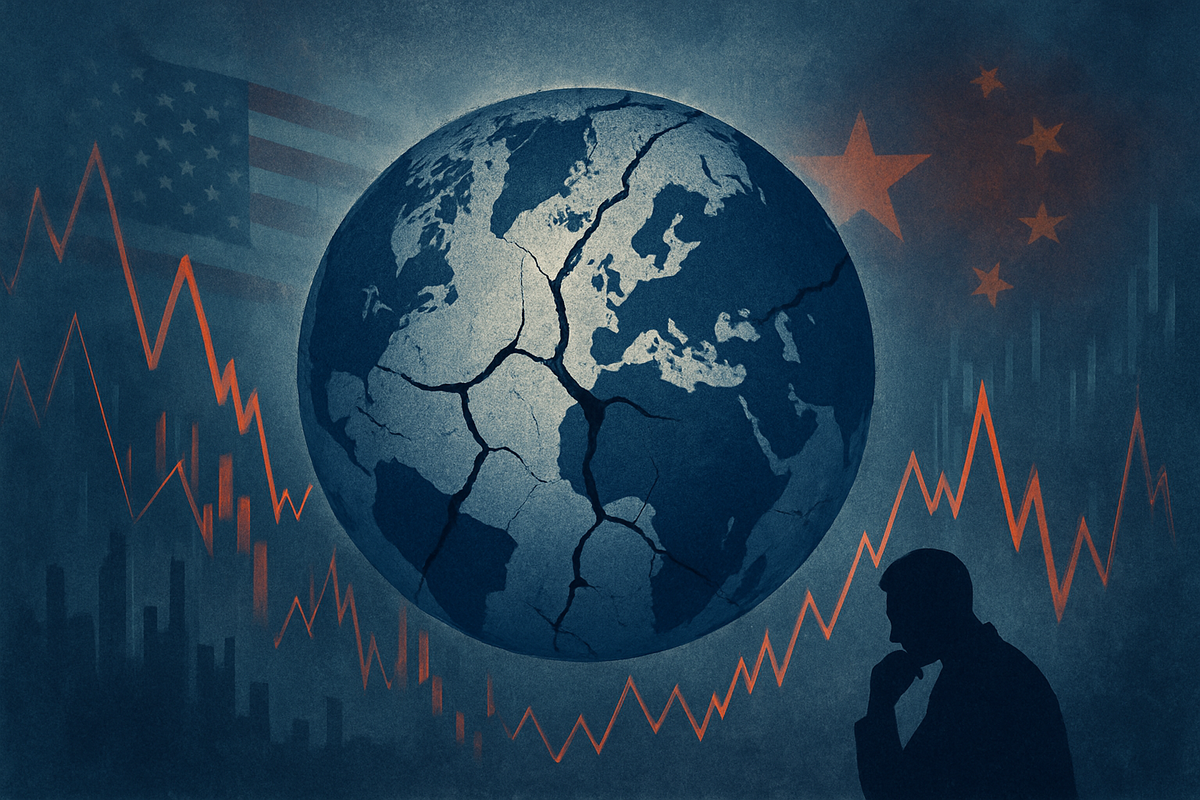
Global financial markets are currently navigating a turbulent sea of geopolitical tensions, with a complex interplay of ongoing conflicts, strategic rivalries, and domestic political instabilities driving significant uncertainty and volatility. As of November 7, 2025, investors are grappling with a fundamental re-evaluation of risk, leading to rapid shifts in sentiment and a pervasive sense of unease. This confluence of events is not merely creating short-term jitters but is fundamentally reshaping global economic relationships and forcing a re-assessment of corporate valuations across the board.
The immediate implications are stark: elevated volatility reflected in a rising CBOE Volatility Index (VIX), a pronounced shift towards defensive assets, and significant stock swings that underscore a market caught between underlying economic resilience and an array of geopolitical headwinds. Key sectors like energy, technology, and global logistics are experiencing direct impacts, ranging from price spikes and supply chain disruptions to altered investment flows. This environment demands agile strategies and a deep integration of geopolitical analysis into financial decision-making.
A World in Flux: Unpacking the Geopolitical Landscape
The current global landscape is defined by several intertwined geopolitical flashpoints, each contributing to market instability. The Russia-Ukraine War continues to be a significant concern, now in its third year. Russia maintains occupation of approximately 19% of Ukrainian territory, with recent intense fighting reported around Pokrovsk. Ukrainian forces are actively targeting Russian energy infrastructure with drone attacks, leading to disruptions in oil refining and export operations, which in turn impacts global energy supply dynamics. Diplomatic efforts to de-escalate the conflict remain largely stalled, with neither U.S. President Donald Trump nor Russian President Vladimir Putin expected to attend the upcoming G20 summit, signaling a continued lack of high-level resolution.
In the Middle East, while a ceasefire agreement was announced in October 2025 between Israel and Hamas, the market remains wary of its durability. Sporadic Israeli operations targeting Hezbollah have reignited fears of broader regional instability. This has already resulted in an estimated $14 billion in economic losses for Lebanon and significantly deterred foreign investment. Beyond direct conflict, these tensions have severely disrupted regional trade, forcing cargo ships to reroute around the Cape of Good Hope. This adds approximately 14 days to shipping times and substantially increases freight and insurance costs, building on the Red Sea crisis that saw a 1.3% decrease in global trade between November and December 2023, with freight prices still elevated in March 2025.
The US-China trade and technology rivalry has seen a notable, albeit cautious, de-escalation with a one-year truce agreed upon during an October 2025 summit between Presidents Trump and Xi Jinping. This agreement includes tariff modifications, commitments to address critical mineral export restrictions, enhanced technology cooperation dialogue, and China's resumption of purchases of U.S. agricultural goods. However, skepticism persists regarding the long-term durability of this truce, as the underlying strategic competition, particularly in critical sectors like semiconductors and artificial intelligence, remains fierce. China has mirrored U.S. tactics by implementing its own extraterritorial export controls on critical minerals and technologies, indicating a continued push for technological self-sufficiency and strategic autonomy.
Domestically, the United States is grappling with an ongoing federal government shutdown, which is significantly contributing to market jitters. This shutdown has led to over 1 million corporate layoffs in the first ten months of 2025, halted the release of crucial economic data, and resulted in a mandated 10% reduction in U.S. air traffic due to a shortage of air traffic controllers and safety concerns. This internal instability creates systemic operational risks, exacerbating economic and human costs and adding another layer of uncertainty for global investors.
Beyond these specific flashpoints, a broader global trend towards economic fragmentation and protectionism is evident. Tariffs are at their highest levels since the 1930s, and countries are increasingly imposing export controls and sanctions. This "weaponization" of trade and supply chains is a defining characteristic of the current geopolitical landscape, profoundly reshaping global industries, trade patterns, and international partnerships.
Corporate Fortunes in a Fractured World
The current geopolitical climate is creating clear winners and losers among public companies, forcing strategic realignments and impacting bottom lines. Companies with diversified supply chains and robust localized operations are better positioned to weather the storm, while those heavily reliant on specific geopolitical hotspots or integrated global supply chains face significant headwinds.
In the energy sector, companies involved in oil and gas production, particularly those with access to stable, non-conflict-affected regions, may see increased demand and potentially higher prices due to supply disruptions. However, companies heavily invested in Russian energy infrastructure or those with significant operations in the Middle East face heightened risk and potential sanctions. For example, major oil companies like ExxonMobil (NYSE: XOM) and Chevron (NYSE: CVX) might benefit from elevated oil prices, but their global operations also expose them to regional instability. Conversely, companies relying on cheap, uninterrupted global shipping for their energy inputs are seeing increased costs. Renewable energy companies, such as NextEra Energy (NYSE: NEE) or Ørsted (CPH: ORSTED), might see increased investment as nations seek energy independence from volatile fossil fuel markets, though they too face supply chain challenges for critical components.
The technology sector is profoundly impacted by the US-China rivalry. Semiconductor manufacturers like Taiwan Semiconductor Manufacturing Company (NYSE: TSM) and NVIDIA (NASDAQ: NVDA) face ongoing uncertainty regarding export controls and market access, despite the recent truce. Companies heavily reliant on Chinese manufacturing or consumer markets, such as Apple (NASDAQ: AAPL), are under pressure to diversify their production bases. Conversely, companies providing cybersecurity solutions or those in defense technology, like Lockheed Martin (NYSE: LMT) or Raytheon Technologies (NYSE: RTX), may see increased government spending and demand due to heightened global tensions. The ongoing US government shutdown could also impact tech companies reliant on federal contracts or regulatory approvals.
Logistics and shipping companies are directly affected by disruptions like the Red Sea crisis. Companies such as Maersk (CPH: MAERSK-B) and Hapag-Lloyd (XTRA: HLAG) are experiencing increased freight rates and longer transit times, which can boost their revenues in the short term, but also lead to higher operational costs and customer dissatisfaction. Companies with strong regional logistics networks or those investing in nearshoring solutions, like Amazon (NASDAQ: AMZN) with its extensive fulfillment network, might gain a competitive advantage by reducing reliance on vulnerable global routes. Conversely, retailers and manufacturers with "just-in-time" inventory models, such as Target (NYSE: TGT) or Nike (NYSE: NKE), are struggling with inflated shipping costs and potential delays, impacting their profit margins and ability to meet consumer demand.
The broader trend of economic fragmentation means that companies with a strong domestic focus or those able to adapt quickly to regional trade blocs may thrive. Companies that have proactively diversified their manufacturing and supply chains away from single points of failure are demonstrating greater resilience. Those that fail to adapt risk becoming entangled in geopolitical crossfire, facing tariffs, sanctions, and reduced market access.
Wider Significance and Historical Echoes
The current wave of geopolitical events signifies a profound shift in the global economic order, moving away from the hyper-globalization of recent decades towards a more fragmented and regionalized system. This trend is not merely a temporary blip but rather an acceleration of "de-globalization" or "slow-balization," where geopolitical considerations increasingly trump purely economic efficiency. This paradigm shift fits into broader industry trends emphasizing supply chain resilience, national security, and strategic autonomy over cost optimization.
The ripple effects are far-reaching, impacting not just direct competitors but entire ecosystems of partners and suppliers. Companies are being forced to re-evaluate their entire value chains, leading to increased investment in reshoring, nearshoring, and friend-shoring initiatives. This means that manufacturing hubs in countries deemed geopolitically stable or allied may see an influx of investment, while those in contentious regions may experience divestment. For instance, countries in Southeast Asia, such as Vietnam and India, are increasingly becoming alternative manufacturing destinations, potentially benefiting companies like Foxconn Technology Group (TWSE: 2317) as they diversify operations away from China.
Regulatory and policy implications are significant. Governments worldwide are enacting more protectionist trade policies, stricter export controls on critical technologies, and increased scrutiny of foreign investments. The U.S. government shutdown, for example, highlights how domestic political instability can have international economic repercussions, affecting everything from trade negotiations to the confidence in U.S. economic data. The European Union, similarly, is grappling with its own energy security and technological sovereignty, leading to policies that favor internal development and diversification of trade partners. This environment necessitates that companies invest heavily in regulatory compliance and government relations to navigate an increasingly complex policy landscape.
Historically, periods of heightened geopolitical tension, such as the Cold War era, also led to economic fragmentation and the formation of distinct economic blocs. During those times, industries like defense, energy, and certain strategic technologies saw significant government backing and protection. Comparisons can also be drawn to the oil shocks of the 1970s, where Middle East conflicts directly impacted global energy prices and triggered recessions. While the current situation is multi-faceted and not solely driven by energy, the weaponization of trade, technology, and supply chains echoes these historical precedents, suggesting a prolonged period where geopolitical risk remains a primary driver of market behavior. The difference now is the intricate interconnectedness of global finance and technology, making the potential for systemic shock even greater.
What Comes Next: Navigating the New Normal
Looking ahead, the global markets face a period of sustained volatility and strategic re-evaluation. In the short term, investors should anticipate continued fluctuations driven by headlines related to the Russia-Ukraine war, Middle East tensions, and the progress (or lack thereof) in US-China relations. The ongoing US government shutdown will also likely cast a shadow, impacting consumer confidence and the availability of critical economic data. Companies will need to prioritize agility, scenario planning, and robust risk management to mitigate immediate shocks.
Longer term, the trend towards economic fragmentation and strategic decoupling is likely to accelerate. This will necessitate significant strategic pivots for many multinational corporations. Companies will need to build more resilient, "just-in-case" supply chains rather than purely "just-in-time" models, investing in redundancy, regionalization, and diversification of suppliers. This could lead to increased capital expenditures in new manufacturing facilities in geopolitically stable regions. Market opportunities may emerge in sectors that benefit from this shift, such as advanced manufacturing, logistics technology, cybersecurity, and renewable energy infrastructure, as nations prioritize self-sufficiency and security.
Potential scenarios range from a gradual stabilization of certain geopolitical flashpoints, leading to cautious market rebounds, to an escalation of conflicts or trade wars, which could trigger deeper market corrections and a prolonged period of economic stagnation. A key outcome to watch is the durability of the US-China truce; a breakdown could reignite significant trade and technology disputes, impacting global growth. Similarly, any major escalation in the Middle East could send oil prices soaring, reigniting inflationary pressures globally.
Companies that adapt by localizing production, diversifying markets, and investing in technological independence will be best positioned. Those that continue to rely on a single globalized model without acknowledging the new geopolitical realities will face significant challenges. The era of purely economically driven decisions is waning, replaced by a complex calculus where geopolitical alignment and national security interests play an increasingly dominant role.
A New Era of Geopolitical Investing
In summary, the current geopolitical landscape, marked by ongoing conflicts, strategic rivalries, and domestic instabilities, has ushered in a new era of sustained volatility and uncertainty in global stock markets. Key takeaways include the necessity for investors to integrate geopolitical analysis deeply into their decision-making processes, recognizing that traditional economic indicators alone are no longer sufficient to gauge market risk. The shift towards economic fragmentation and protectionism is a defining trend, reshaping supply chains, trade patterns, and international partnerships.
Moving forward, the market will likely remain sensitive to developments in the Russia-Ukraine war, Middle East tensions, and the delicate US-China relationship. The resolution or prolongation of the US government shutdown will also be a critical factor influencing investor sentiment. Companies that demonstrate resilience through diversified operations, localized supply chains, and strategic technological investments are better poised to thrive.
Investors should watch for signs of further economic decoupling, new trade policies, and shifts in global alliances. The performance of key sectors like energy, technology, and logistics will continue to be highly correlated with geopolitical events. While some emerging markets, such as India and Southeast Asia, may offer pockets of growth as alternatives to traditional manufacturing hubs, they too remain vulnerable to broader global corrections. The coming months will be crucial in determining whether the current turbulence settles into a new, albeit more volatile, equilibrium, or if further escalations lead to more profound structural changes in the global financial system.
This content is intended for informational purposes only and is not financial advice





